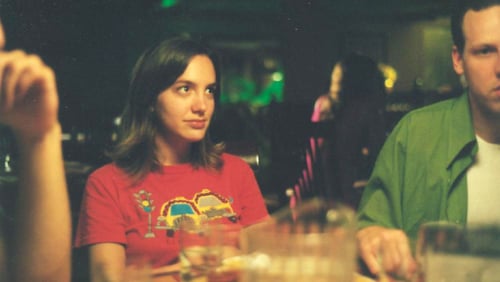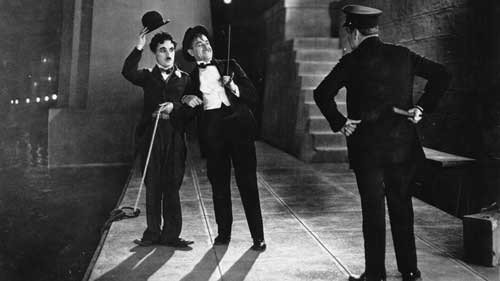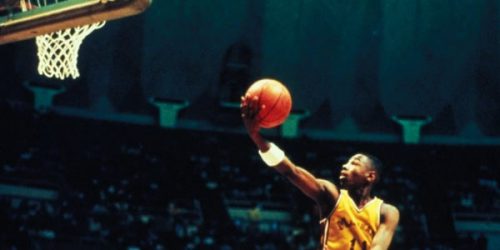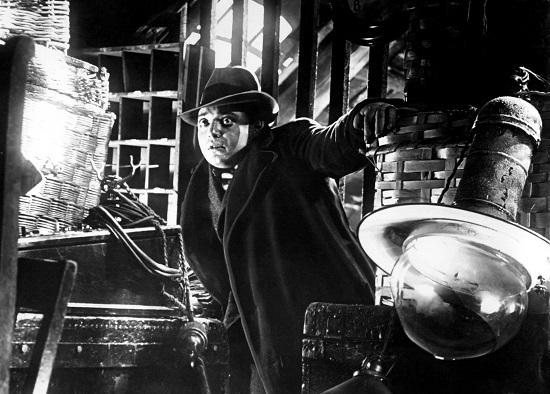Cinematic Styles – Tip: There’s More Than One
As a filmmaker (and as a human), I’ve been on a long journey. I first dreamed of being a film director at the age of 7. My dad bought me a tripod, a standard 8mm cine camera, a projector, a thing for viewing your film and marking edit points and a splicer.
That means I first became aware of cinema as a thing in the 1970s. And I wanted to make some myself.
I remember at 8 years old trying to shoot a Western with my friend. We did the thing with the drink sliding across the bar and shot a gunfight in slow motion. We had no guns so we had to use our fingers as pistols. Would it have impressed Sam Peckinpah (the master of the slow motion gun battle)? I guess not.
I also remember being in the living room alone, practicing dying dramatically. Slumping to the ground, my grip on life fading until I slowly expelled my last breath. Death was a glorious thing.
Especially when you can jump up and have another go at it. I don’t remember exactly how many imaginary takes it took to perfect my early demise, but one go was certainly not adequate. I wanted to see how it felt dying in different ways.
Anyway, I wasn’t thinking about it at the time but it seems I was aware that not all movies looked the same. Plus I had already grasped one important concept – drama needed repeated attempts to get right.
How do I make my videos look more cinematic?
This is a frequently asked question which any number of bloggers and YouTubers are queuing up to satisfy. A simple answer is often the most effective at getting attention. And so internet has converted the word “cinematic” to mean slow motion, smooth gliding shots, saturated colours, shallow depth of field and so on. A bit like my 8 year old idea of a Western was slow motion gunfights and glasses of whisky sliding along bars.
Often, those in search for the cinematic Holy Grail have no intention of making something to be shown in a cinema. It’s more about making their videos look cool and sexy, for whatever purpose. Perhaps they simply want to make their YouTube channel look a bit more professional and impressive.
I have no problem with that at all.
But if you want a deeper understanding of cinema, you’ll have to look into the history of it. Cinematic styles have changed quite a bit since it’s invention over a 100 years ago. Right now, we seem to be in the age of the Computer Generated cinema experience.
However, even CGI artists will get their inspiration from the huge wealth of cinematic techniques and styles upon which this most magical of mediums is built on.
Choosing a cinematic style
Before you shoot a film, it’s advisable to have a clear plan for the style you want to shoot it in. If you look at cinema as an artform, then the style you shoot in is only limited by your imagination. Art is at its heart creative and expressive and you can’t be those things locked into a checklist of what makes a video “cinematic”.
Imagine being a painter and only being allowed to work with 2 colours. Worse, imagine being a painter and believing there were only 2 colours in existence.
As a filmmaker, learning about the history of cinema and watching films made in a variety of cinematic styles will give you more colours to paint with. Why limit yourself?
When I shot ReGen (episode 2 of Silent Eye), I chose to shoot a sci-fi but in a handheld, “Cinéma vérité” style. With science fiction, we tend to expect very polished, graceful visuals. Whereas the rough, jerky cinéma vérité style is something we’re used to seeing more in documentaries or dramas.
But I wanted to try something different. The film is about a group of Bitcoin thieves using a new medical advancement to come back from the dead. The way I shot it, the camera was like an unseen member of the gang, moving around amongst them.
This generated a more urgent, realistic feel. I felt this would work for the subject, especially the scenes where they’re bringing someone back from the dead. The mood I wanted to create was one of frenzied urgency.
What is a cinematic style?
Cinematic style refers to exactly what I just described above. It’s a way or method of filming and editing to create a certain feeling in the viewer. Essentially, in the end it comes down to the story you want to tell and how you want to tell it.
Without doubt, regarding cinema, how you tell a story is of equal importance to the story itself. Throughout the history of cinema, filmmakers have experimented with different methods and techniques, because that’s what artists do.
Some of those cinematic styles became so important they left a mark and changed cinema forever. Some filmmakers were so important to the development of cinema, they became cinematic styles themselves. For example, the word “Hitchcockian” refers to a style of film likened to the works of cinema’s legendary master of suspense, Alfred Hitchcock.
Like other artforms, there’s more cinematic styles than you can fit into one blog post. But let’s look at some of the main ones.
Silent Movies
Silent films are film with no synchronized recorded sound. In the early days of cinema, it wasn’t possible to have synchronised audio playing with the film. Instead, when played in a theatre, films would be accompanied by musicians – usually a pianist or organist.
For this reason, films from the silent era are often held up as examples of great visual storytelling. Filmmakers at the time simply had no choice but to try to convey as much of the story as possible with images. They could also use “title cards” to indicated key lines of dialogue, but were used sparingly. Interrupting the action with constant title cards for the audience to read would not have been popular and would have taken viewers out of the film.
The acting in silent films is often exaggerated, partly to compensate for the lack of sound but also because audiences and actors of the time were used to more a more theatrical style.
Film schools often recommend students watch silent films to better appreciate the raw power of the medium of the moving image.
Some recommended silent films are: City Lights (1931), Earth (1930), Battleship Potemkin (1925), The General (1926), Metropolis (1927), The Wind (1928), The Cabinet of Dr Caligari (1920), The Lodger, Sunrise: A Song of Two Humans (1927) and the incredible The Passion of Joan of Arc (1928).
The downside of sound
While the introduction of sound was a game changer for cinema, it also had some negative effects. Some famous actors with weak voices found themselves out of work. Also, a silent film could be shot in any language and exported around the world. All you had to do was change the language of the title cards. With sound that was no longer possible.
The introduction of sound also had a temporary negative effect on cinematography, as cameras had to be housed in sound proofed boxes and so could no longer move during a shot. But these issues were eventually overcome and cameras were mobile once again.
Film noir
One of the most popular cinematic styles is film noir, which reached its peak in America around the 1940-1950s. The films are generally low budget crime thrillers with small casts and shot in black and white. Visual motifs include dramatic, high contrast lighting, morally ambiguous characters, the greater use of exposition in dialogue. The stories often depict cynical attitudes and sexual motivations.
Some recommended film noirs are: They Live by Night (1948), Kiss Me Deadly (1955), Blood Simple (1984), Ascenseur pour l’échafaud (1958), The Third Man (1949), Out of the Past (1947), Double Indemnity (1944), Touch of Evil (1958), Chinatown (1974), The Big Sleep (1946).
You might also include the iconic sci-fi noir Blade Runner (1982) in that list.
Cinéma vérité
Sometimes called observational cinema, the method combines improvisation with the use of the camera in a quest for more “truth”. The goal is a more authentic depiction of reality than the typically “theatrical” method of cinema.
This is documentary-style filmmaking, sometimes referred to as “fly on the wall”. This term refers to the camera being reduced to a passive observer thereby (in theory) to present an undoctored version of events. In simple terms, the film is presented in a more raw form. For example, using a handheld jerky camera style.
In general, this style evokes a feeling of spontaneity and connects well with improvisation. Another clue is that the camera appears to be responding to events, as opposed to a methodically premeditated camera movement.
For example, a lot of mockumantaries now use this method. The camera chancing upon characters, zooming or focusing seemingly at the instinctive whim of the operator.
There’s whole bookshop worth of theory on the subject of Cinéma vérité but this is my take on it. For practical purposes, it’s a blurring of the line between fact and fiction, between theatre and documentary.
Some examples of Cinéma vérité worth checking out: Crisis: Behind a Presidential Commitment (1963), Dancer in the Dark (2000), Shadows (1959), Faces (1968), Gimme Shelter (1970), The Act of Killing (2012), Hoop Dreams (1994), The War Room (1993), A Married Couple (1969).
German Expressionism
German expressionism in cinema is really a subset of the silent film era. Of course, all cinematic styles are generalisations around which the edges are blurred. But it’s a way of categorising a certain movement or trend in filmmaking, to easier study and learn from those films.
In a way, expressionism in cinema is the counterbalance to Cinéma vérité. Rather than realism and non-manipulative camerawork, expressionist films use the camera to attempt to get inside the mind of the characters depicted. While vérité quests for objective unbiased truth, expressionist cinema is explores a more subjective experience.
Visual characteristics are tilting camera, impossible sets, high angles and deep shadows. The style went on to influence many later filmmakers, including Orson Welles and Alfred Hitchcock.
Good examples of German Expressionist films are: The Cabinet of Dr. Caligari (1920), Nosferatu (1922), Metropolis (1927), The Golem (1920), M (1931), From Morn to Midnight (1920), Warning Shadows (1923), The Hands of Orlac (1924), Waxworks (1924), Variety (1925), The Student of Prague (1926).
Many of these films have a disturbing, nightmarish quality to them. Not surprising then that you’ll find Welles using those influences in films like A Touch of Evil and Macbeth and Hitchcock in Psycho, Vertigo, The Birds and others.
Italian Neorealism
As Expressionism came out of the post World War 1 aftermath for Germans, World War 2 inspired Italians to create their Neorealism movement. However, the result was quite different. Filmmakers took to the streets to film stories about ordinary people struggling to get by.
Connected to a magazine called Cinema, a circle of film critics developed the neorealist style. As a counter to the popular mainstream films, some felt Italian cinema should turn towards realism. In time, Italian cinema went from shooting on enclosed studio sets to public locations in the countryside and city streets.
Neorealist films were usually filmed with nonprofessional actors. Sometimes well-known actors would be cast but play against their normal character types. The depiction is of the mundane and unselfconscious. Children often feature, but as observers rather than participants.
This quest for truth and realism was echoed later in La Nouvelle Vague (aka French New Wave). In the 1950s, the Italian economic miracle made the Neorealism movement redundant and it quickly faded.
Some Italian Neorealist films to put on your watch list: Rome, Open City (1945), Bicycle Thieves (1948), La Terra Trema (1948), Paisan (1946), Umberto D. (1952), Shoeshine (1946), Ossessione (1943), Bitter Rice (1949), Stromboli (1950), Bellissima (1951), Miracle in Milan (1951), Rome 11:00 (1952), Europe ’51 ((1952).
La Nouvelle Vague
Some people consider the French New Wave to be the most influential cinematic styles in the history of cinema. The term came from a group of French film critics and cinephiles connected to a film magazine called Cahiers du cinéma. The movement was a rebellion against the traditional film conventions of the time.
The New Wave of French cinema involved radical experimentation with editing, visual style and narrative. Many films of this era covered the social and political upheaval of the time. New Wave filmmakers often used portable equipment and requiring little or no set up time. They used live sound and film stock which required less artificial lighting.
Editing was sometimes fragmented and jumping, like YouTubers use today to quicken the tempo of a single take from a single angle. The jump cut was innovative and fresh at the time, but also a way of saving money. In contrast, long drawn-out takes were used as a bold act against traditional filmmaking convention.
Whereas Expressionism was subjective reality and Neorealism was objective reality, the New Wave was often a creative mixture of the two. This was a fresh approach, with improvised dialogue, rapid scene changes and shots that broke the standard 180° rule.
The influence of this movement was huge. Ironically, the movement which was founded in spirit of iconoclasm (the destruction of icons) ended up inspiring such filmmaking icons as Steven Spielberg, Martin Scorsese, George Lucas and Francis Ford Coppola.
French New Wave films to add to your watch list: The 400 Blows (1959), Breathless (1960), Hiroshima, Mon Amour (1959), Les Bonnes Femmes (1960), Shoot the Piano Player (1960), Jules and Jim (1962), My Life to Live (1962), Contempt (1963), Lola (1961), Adieu Philippine (1962), Cléo from 5 to 7 (1962), Claire’s Knee (1970).
Mumblecore
Mumblecore arrived at the beginning of this century. The movement is child of Cinéma vérité, Italian Neorealism, French New Wave and the American films of the 1970s, 80s and 90s influenced by them. Key features include natural performances and dialogue, in an improvisational style.
Like the French New Wave, Mumblecore films are generally micro-to-low budget and filmed in real locations. Music soundtracks tend to be limited or nonexistent. The characters portrayed are in their twenties or early thirties, usually single, white and aimless. The stories revolve around difficult relationships and characters’ inability to express their desires.
Mumblecore films to add to your watch list: Funny Ha ha (2002), The Puffy Chair (2005), Hannah Takes the Stairs (2007), LOL (2006), Baghead (2008), Beeswax (2009), Mutual Appreciation (2005).

Eager to learn more?
Join our weekly newsletter featuring inspiring stories, no-budget filmmaking tips and comprehensive equipment reviews to help you turn your film projects into reality!
Simon Horrocks
Simon Horrocks is a screenwriter & filmmaker. His debut feature THIRD CONTACT was shot on a consumer camcorder and premiered at the BFI IMAX in 2013. His shot-on-smartphones sci-fi series SILENT EYE featured on Amazon Prime. He now runs a popular Patreon page which offers online courses for beginners, customised tips and more: www.patreon.com/SilentEye







